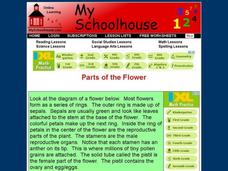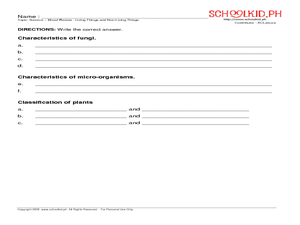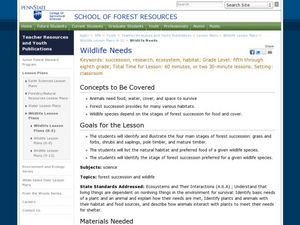Curated OER
Putting on Mass: Just how do Trees grow?
Students articulate an explanation of photosynthesis. They identify problems they have with comprehension of how a plant gains mass. Students describe a historical experiment.
Curated OER
Pizza Garden
Students get involved in growing veggies so they may start eating them more!
Curated OER
What is a bird?
Students sort birds by their physical characteristics. In this bird characteristics lesson, students review bird characteristics and create beaks. Students discuss birds as pets.
Curated OER
Pottery Traditions
Students make and decorate a replica of a North Carolina coiled pot after summarizing why archaeologists study pottery and how Indian people of North Carolina made and used coiled pottery.
Curated OER
Bird Beaks and Feet
In this bird adaptations worksheet, students look at different bird pictures and determine what the bird eats and where it lives by looking at its beak and feet. Students complete a graphic organizer and 5 short answer questions.
Curated OER
We're Building Heroes
Students discuss their ideas of the qualities a hero possesses. In this attributes of a hero lesson plan, students construct a hero puzzle and identify qualities of a hero in storybook characters.
Curated OER
Plant Reproduction
In this plant reproduction worksheet, students complete a crossword puzzle with 36 questions. They identify the different plant reproductive features.
Curated OER
Mushroom Prints
Students create a mushroom spore design on paper while studying the facts on fungi.
Curated OER
The Peanut Wizard
Peanuts inspire this lesson about George Washington Carver, called The Peanut Wizard in the included informational text. Class members read about peanuts and George Washington Carver and create a timeline of his life. In addition, pupils...
Curated OER
Ferns and Gymnosperms
In this fern and gymnosperm learning exercise, students will read about two types of vascular tissue: xylem and phloem. Then students will read about the difference between sporophytes and gametophytes. Using this information students...
Curated OER
Parts of the Flower
In this biology worksheet, students examine a diagram of a flower and read a selection that describes all of the parts including the petals, the stamen, the anther, and the sepals. They answer 11 on-line fill in the blank questions using...
Curated OER
Ferns and Gymnosperms
In this plant worksheet, students review the different characteristics of ferns and gymnosperms. This worksheet has 12 fill in the blank questions.
Curated OER
Global Environmental Change
Students examine environmental change of land, water, and air, discuss Clear Skies Legislation, and experiment on solid compaction and
resultant water filtration.
Curated OER
Recyclers Revisited
Fifth graders observe their plant experiments that they started in a previous lesson and examine the role of decomposers in the nitrogen cycle. Two weeks after they set up a worm terrarium, they analyze any changes they observe, and...
Curated OER
Pollination
Third graders discuss pollination and how bees pollinate flowers. In this pollination lesson plan, 3rd graders draw the pollination process on a piece of paper.
Curated OER
Cinderella: Literacy Skills Packet
In this Cinderella worksheet packet, students can practice their literacy skills by unscrambling vocabulary words, doing a crossword puzzle, completing a story sequence activity, answering eight short answer questions, and completing one...
Curated OER
Science - Mixed Review: Living Things and Non Living Things
In this living and non living things worksheet, students fill in a mixed review that has them answering questions in the true and false, short answer, and classification formats. Students answer 59 questions.
Curated OER
Home Sweet Home
Students examine the animals that live in trees. They identify their sounds, footprints and droppings. They draw pictures of the animals as well.
Curated OER
Fossil Impressions of Ancient Life
Students make a mold using Plaster of Paris and then make a cast using that same mold. They pick a fossil and describe how it looks. They write a fictionalized story about its life, or burial. (
Curated OER
Wildlife Needs
Students identify the wildlife needs in a specific setting. For this wildlife needs lesson, students identify and illustrate the four stages of forest succession. Students list the natural habitat and food for a given species. Students...
Curated OER
The Ice Age
Students study the ice age and the causes of it. In this Ice Age lesson plan students examine why those animals became extinct and complete activity sheets.
Curated OER
Eat A Rainbow!
Learners demonstrate the importance of eating fruits and vegetables. In this nutrition lesson, students identify and sort different fruits and vegetables by colors. Learners list reasons why eating fruits and vegetables are important and...
Curated OER
Fall vs. Spring
Young scholars compare and contrast the seasons of fall and spring. In this fall and spring lesson plan, students learn the differences between fall and spring through books and pictures, identify the differences, draw their own...
Curated OER
Explorations Through Time
In this earth history worksheet, high schoolers visit a website and complete 15 fill in the blank and 8 short answer questions based on what they read. Topics include biodiversity, animal kingdoms, evolution, fossils, and extinction.

























